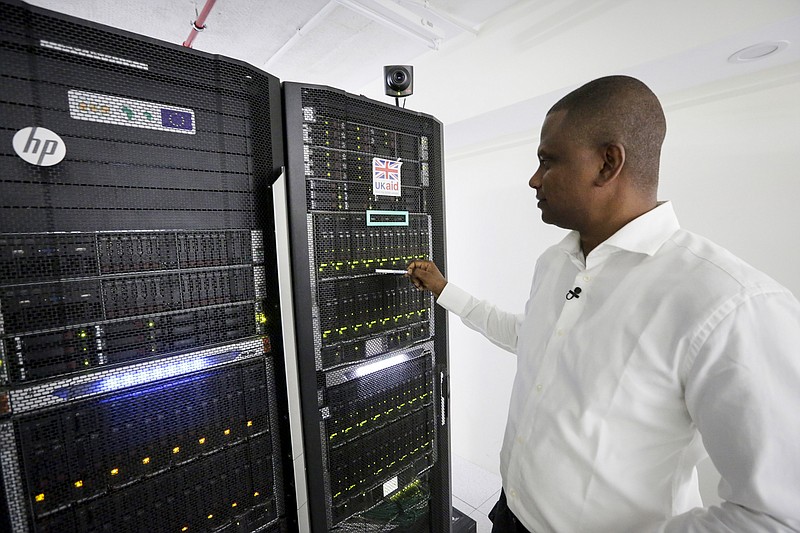The state's $400 million broadband investment will likely not be enough to provide coverage to all of Missouri's unserved and underserved communities, the state broadband development director said.
In August, Gov. Mike Parson announced the state would be investing $400 million in broadband infrastructure targeting unserved and underserved areas throughout Missouri.
The House Subcommittee on Federal Stimulus Spending held a hearing Wednesday to receive updates from the House Special Interim Committee on Broadband Development and the state director of Broadband Development.
The subcommittee, chaired by Rep. Doug Richey, R-Excelsior Springs, is looking at ways the state can spend federal COVID-19 relief funds. Among their considerations are broadband infrastructure, state technology upgrades and more.
Tim Arbeiter, broadband development director within the Missouri Department of Economic Development, said the governor's cabinet has been working with state agencies on what exactly that investment will look like and how many people it will serve.
"My best educated answer right now is no, it's not going to take care of it," Arbeiter said.
Currently, there are 14 project ideas under consideration, Arbeiter said, and they are expected to impact an estimated 342,000 households or individuals and cost $401.1 million - slightly over the initial commitment.
Missouri is currently ranked 34th in the country for broadband access, he said.
Roughly 147,046 households and 392,364 individuals in the state are considered unserved or underserved by internet providers, according to the Federal Communications Commission.
Those figures have improved since 2018, which Arbeiter said has been a result of federal spending on broadband infrastructure.
The state's 14 projects fall into three categories:
Nine are related to providing access through increasing the state's broadband infrastructure;
Three are concerned with promoting broadband adoption and getting citizens connected in areas that already have access;
Two are related to assistance or providing technical support to Missourians.
He said the state is focused on developing a broadband community toolkit this month, which involves building a cross-agency team, engaging promotional partners and deploying a toolkit to stakeholders.
Increasing broadband infrastructure makes up a bulk of the state's investment as the nine projects are expected to cost roughly $269.4 million of the $401.1 million and serve an estimated 256,000 households or individuals.
Through the fall and winter, Arbeiter said they will be working to find an engineering firm, identify infrastructure gaps and determine costs to close the gaps. By spring of next year, work to confirm priority projects, scoping construction and engineering, and preparing for implementation will be done.
Missouri's unserved and underserved areas often don't have coverage because they have difficult terrain, he said, which becomes costlier and more difficult for providers to reach.
"Whether it be on the poles or burrowed under the rock, this is not going to be a cheap venture," Arbeiter said.
State Rep. Louis Riggs, R-Hannibal, is chairman of the Special Interim Committee on Broadband Development and said time is of the essence for developing broadband infrastructure - not only to serve those without broadband access but also to comply with funding regulations.
The federal funding is provided through the American Rescue Plan Act signed by President Joe Biden in March. It requires states to have the funds designated by 2024 and spent by 2026.
"Everybody in the building gets it. We all get it. The question is how do we accomplish this in the best way humanly possible," Riggs said. "We all understand 2022 is the year. This is a once-in-a-lifetime opportunity with these federal dollars coming at us from different directions."
While it won't completely address the state's unserved and underserved areas, Riggs said the state's investment should condense the timeline on addressing the need and make significant headway in areas where lack of broadband access is a barrier.
"It accomplishes a lot," Riggs said. "I'm taking a look at some of the buckets that we're talking about and it gets us in a really place with workforce development, it gets us in a good place with the state broadband fund, it gets us in a real good place with telemedicine and it gets us in a good place with entrepreneurship."
With remote work and internet capability increasing in demand around the state, Riggs said investment in broadband infrastructure is a good way for Missouri to encourage growth.
He said getting local municipalities and county commissioners to use their federal ARPA funds for broadband development could further the state's approach.
Throughout the hearing, subcommittee members raised concerns about price disparities among customers who have the same provider, subsidizing broadband prices artificially raising the price of internet, and how the $401.1 million would be spent across fiscal years.
Arbeiter said the cabinet will need to work with the state budget director to determine how much can be spent on broadband projects each fiscal year, but the $401.1 million commitment is likely a multi-year request.

